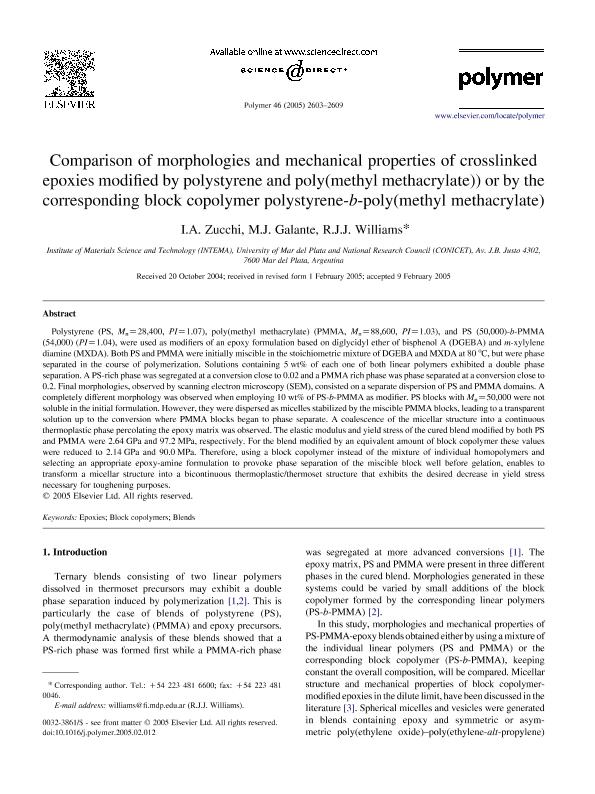Mostrar el registro sencillo del ítem
dc.contributor.author
Zucchi, Ileana Alicia

dc.contributor.author
Galante, Maria Jose

dc.contributor.author
Williams, Roberto Juan Jose

dc.date.available
2019-08-29T20:25:09Z
dc.date.issued
2005-03
dc.identifier.citation
Zucchi, Ileana Alicia; Galante, Maria Jose; Williams, Roberto Juan Jose; Comparison of morphologies and mechanical properties of crosslinked epoxies modified by polystyrene and poly(methyl methacrylate)) or by the corresponding block copolymer polystyrene-b-poly(methyl methacrylate); Elsevier; Polymer; 46; 8; 3-2005; 2603-2609
dc.identifier.issn
0032-3861
dc.identifier.uri
http://hdl.handle.net/11336/82533
dc.description.abstract
Polystyrene (PS, Mn=28,400, PI=1.07), poly(methyl methacrylate) (PMMA, Mn=88,600, PI=1.03), and PS (50,000)-b-PMMA (54,000) (PI=1.04), were used as modifiers of an epoxy formulation based on diglycidyl ether of bisphenol A (DGEBA) and m-xylylene diamine (MXDA). Both PS and PMMA were initially miscible in the stoichiometric mixture of DGEBA and MXDA at 80°C, but were phase separated in the course of polymerization. Solutions containing 5 wt% of each one of both linear polymers exhibited a double phase separation. A PS-rich phase was segregated at a conversion close to 0.02 and a PMMA rich phase was phase separated at a conversion close to 0.2. Final morphologies, observed by scanning electron microscopy (SEM), consisted on a separate dispersion of PS and PMMA domains. A completely different morphology was observed when employing 10 wt% of PS-b-PMMA as modifier. PS blocks with Mn=50,000 were not soluble in the initial formulation. However, they were dispersed as micelles stabilized by the miscible PMMA blocks, leading to a transparent solution up to the conversion where PMMA blocks began to phase separate. A coalescence of the micellar structure into a continuous thermoplastic phase percolating the epoxy matrix was observed. The elastic modulus and yield stress of the cured blend modified by both PS and PMMA were 2.64 GPa and 97.2 MPa, respectively. For the blend modified by an equivalent amount of block copolymer these values were reduced to 2.14 GPa and 90.0 MPa. Therefore, using a block copolymer instead of the mixture of individual homopolymers and selecting an appropriate epoxy-amine formulation to provoke phase separation of the miscible block well before gelation, enables to transform a micellar structure into a bicontinuous thermoplastic/thermoset structure that exhibits the desired decrease in yield stress necessary for toughening purposes.
dc.format
application/pdf
dc.language.iso
eng
dc.publisher
Elsevier

dc.rights
info:eu-repo/semantics/openAccess
dc.rights.uri
https://creativecommons.org/licenses/by-nc-nd/2.5/ar/
dc.subject
Blends
dc.subject
Block Copolymers
dc.subject
Epoxies
dc.subject.classification
Ingeniería Química

dc.subject.classification
Ingeniería Química

dc.subject.classification
INGENIERÍAS Y TECNOLOGÍAS

dc.subject.classification
Físico-Química, Ciencia de los Polímeros, Electroquímica

dc.subject.classification
Ciencias Químicas

dc.subject.classification
CIENCIAS NATURALES Y EXACTAS

dc.title
Comparison of morphologies and mechanical properties of crosslinked epoxies modified by polystyrene and poly(methyl methacrylate)) or by the corresponding block copolymer polystyrene-b-poly(methyl methacrylate)
dc.type
info:eu-repo/semantics/article
dc.type
info:ar-repo/semantics/artículo
dc.type
info:eu-repo/semantics/publishedVersion
dc.date.updated
2019-08-27T18:46:53Z
dc.journal.volume
46
dc.journal.number
8
dc.journal.pagination
2603-2609
dc.journal.pais
Países Bajos

dc.journal.ciudad
Amsterdam
dc.description.fil
Fil: Zucchi, Ileana Alicia. Consejo Nacional de Investigaciones Científicas y Técnicas. Centro Científico Tecnológico Conicet - Mar del Plata. Instituto de Investigaciones en Ciencia y Tecnología de Materiales. Universidad Nacional de Mar del Plata. Facultad de Ingeniería. Instituto de Investigaciones en Ciencia y Tecnología de Materiales; Argentina
dc.description.fil
Fil: Galante, Maria Jose. Consejo Nacional de Investigaciones Científicas y Técnicas. Centro Científico Tecnológico Conicet - Mar del Plata. Instituto de Investigaciones en Ciencia y Tecnología de Materiales. Universidad Nacional de Mar del Plata. Facultad de Ingeniería. Instituto de Investigaciones en Ciencia y Tecnología de Materiales; Argentina
dc.description.fil
Fil: Williams, Roberto Juan Jose. Consejo Nacional de Investigaciones Científicas y Técnicas. Centro Científico Tecnológico Conicet - Mar del Plata. Instituto de Investigaciones en Ciencia y Tecnología de Materiales. Universidad Nacional de Mar del Plata. Facultad de Ingeniería. Instituto de Investigaciones en Ciencia y Tecnología de Materiales; Argentina
dc.journal.title
Polymer

dc.relation.alternativeid
info:eu-repo/semantics/altIdentifier/url/https://www.sciencedirect.com/science/article/pii/S0032386105001448
dc.relation.alternativeid
info:eu-repo/semantics/altIdentifier/doi/http://dx.doi.org/10.1016/j.polymer.2005.02.012
Archivos asociados
